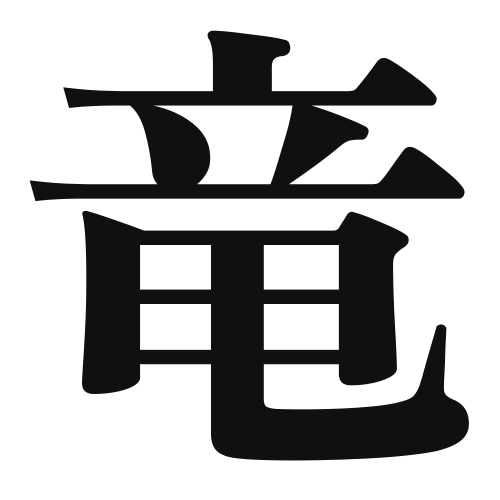1. Overview of Meaning
The kanji “竜” (pronounced “ryū” in Japanese) means “dragon.” It represents a mythical creature that is often associated with power, strength, and good fortune in various cultures, particularly in East Asia.
2. Formation and Radical
Formation of the Kanji: The kanji “竜” is a phonetic-ideographic character (形声文字). It combines elements that suggest both sound and meaning. The character is derived from the ancient Chinese representation of a dragon, which has evolved over time.
Radical: The radical for “竜” is “立” (meaning “to stand”), which is found at the bottom of the character. This radical often relates to standing or being upright, which can symbolize the majestic nature of dragons.
3. Examples of Usage
Common Words and Phrases: Some frequently used words that include “竜” are:
- 竜巻 (たつまき, “tatsumaki”) – tornado
- 竜神 (りゅうじん, “ryūjin”) – dragon god
- 竜胆 (りんどう, “rindō”) – gentian (a type of flower)
Example Sentences in Daily Conversation:
- 「彼は竜のように強いです。」(かれはりゅうのようにつよいです。) – “He is strong like a dragon.”
- 「竜巻が近くで発生しました。」(たつまきがちかくではっせいしました。) – “A tornado has occurred nearby.”
4. Synonyms and Antonyms
Similar Kanji: A similar kanji is “龍” (also pronounced “ryū”), which is another form of the character for “dragon.” While both characters refer to dragons, “竜” is more commonly used in modern Japanese, whereas “龍” is often found in more formal or traditional contexts.
Antonyms: There are no direct antonyms for “竜,” as it represents a mythical creature. However, one could consider “虫” (むし, “mushi”) meaning “insect” as a contrasting representation of a smaller, less powerful creature.
5. Cultural and Historical Background
Connection to Japanese Culture: In Japanese culture, dragons are revered as symbols of strength and protection. They are often depicted in art, literature, and festivals, representing water and agriculture.
Proverbs and Idioms: One common idiom is “竜頭蛇尾” (りゅうとうだび, “ryūtōdabi”), which means “a dragon’s head and a snake’s tail,” referring to something that starts off strong but ends weakly. This reflects the cultural significance of dragons as powerful beings.
